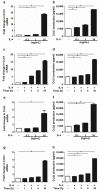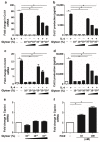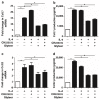Glyteer, Soybean Tar, Impairs IL-4/Stat6 Signaling in Murine Bone Marrow-Derived Dendritic Cells: The Basis of Its Therapeutic Effect on Atopic Dermatitis
- PMID: 29649105
- PMCID: PMC5979322
- DOI: 10.3390/ijms19041169
Glyteer, Soybean Tar, Impairs IL-4/Stat6 Signaling in Murine Bone Marrow-Derived Dendritic Cells: The Basis of Its Therapeutic Effect on Atopic Dermatitis
Abstract
Atopic dermatitis (AD) is a common inflammatory skin disease. Recent studies have revealed the involvement of T helper (Th)2 cytokines including Interleukin 4 (IL-4) in the pathogenesis of AD. Since epidermal Langerhans cells (LCs) and dermal myeloid dendritic cells (DCs) produce CCL17 and CCL22 that chemoattract Th2 cells, interfering with CCL17 and CCL22 production from LCs and dermal myeloid DCs may be beneficial in the treatment of AD. To investigate this, we stimulated murine bone marrow-derived DCs (BMDCs) with IL-4. IL-4 stimulation produced Ccl17 and Ccl22, which was attenuated by soybean tar Glyteer, a known aryl hydrocarbon receptor (Ahr) activator. Notably, Glyteer treatment blocked the nuclear translocation of Stat6 induced by IL-4 stimulation, suggesting that this treatment impairs the IL-4/Stat6 signaling pathway in BMDCs. Unexpectedly, Glyteer treatment did not potently upregulate the expression of Cyp1a1, a specific Ahr-responsive gene, suggesting that its inhibitory machinery for Ccl17 and Ccl22 expression is likely to operate in an Ahr-independent manner. These findings indicate that Glyteer may exhibit therapeutic potential for AD by downregulating the CCL17 and CCL22 production from DCs in a Th2-deviated microenvironment.
Keywords: Ccl17; Ccl22; aryl hydrocarbon receptor; atopic dermatitis; dendritic cell.
Conflict of interest statement
The authors have no conflicts of interest.
Figures




Similar articles
-
IL-4 Augments IL-31/IL-31 Receptor Alpha Interaction Leading to Enhanced Ccl 17 and Ccl 22 Production in Dendritic Cells: Implications for Atopic Dermatitis.Int J Mol Sci. 2019 Aug 20;20(16):4053. doi: 10.3390/ijms20164053. Int J Mol Sci. 2019. PMID: 31434203 Free PMC article.
-
Inhibitory effect of 5,6-dihydroergosteol-glucoside on atopic dermatitis-like skin lesions via suppression of NF-κB and STAT activation.J Dermatol Sci. 2015 Sep;79(3):252-61. doi: 10.1016/j.jdermsci.2015.06.005. Epub 2015 Jun 15. J Dermatol Sci. 2015. PMID: 26100037
-
Blockage of sphingosine-1-phosphate receptor 2 attenuates 2,4-dinitrochlorobenzene-induced atopic dermatitis in mice.Acta Pharmacol Sin. 2020 Nov;41(11):1487-1496. doi: 10.1038/s41401-020-0412-8. Epub 2020 May 26. Acta Pharmacol Sin. 2020. PMID: 32457418 Free PMC article.
-
Regulation of Filaggrin, Loricrin, and Involucrin by IL-4, IL-13, IL-17A, IL-22, AHR, and NRF2: Pathogenic Implications in Atopic Dermatitis.Int J Mol Sci. 2020 Jul 29;21(15):5382. doi: 10.3390/ijms21155382. Int J Mol Sci. 2020. PMID: 32751111 Free PMC article. Review.
-
Regulation of macrophage-derived chemokine (MDC, CCL22) production.Crit Rev Immunol. 2002;22(2):105-14. Crit Rev Immunol. 2002. PMID: 12433129 Review.
Cited by
-
Tryptophan, an important link in regulating the complex network of skin immunology response in atopic dermatitis.Front Immunol. 2024 Jan 22;14:1300378. doi: 10.3389/fimmu.2023.1300378. eCollection 2023. Front Immunol. 2024. PMID: 38318507 Free PMC article. Review.
-
Genome-Wide Transcriptional Analysis Reveals Novel AhR Targets That Regulate Dendritic Cell Function during Influenza A Virus Infection.Immunohorizons. 2019 Jun 17;3(6):219-235. doi: 10.4049/immunohorizons.1900004. Immunohorizons. 2019. PMID: 31356168 Free PMC article.
-
Dendritic Cell-Mediated Th2 Immunity and Immune Disorders.Int J Mol Sci. 2019 May 1;20(9):2159. doi: 10.3390/ijms20092159. Int J Mol Sci. 2019. PMID: 31052382 Free PMC article. Review.
-
IL-4 Augments IL-31/IL-31 Receptor Alpha Interaction Leading to Enhanced Ccl 17 and Ccl 22 Production in Dendritic Cells: Implications for Atopic Dermatitis.Int J Mol Sci. 2019 Aug 20;20(16):4053. doi: 10.3390/ijms20164053. Int J Mol Sci. 2019. PMID: 31434203 Free PMC article.
-
Myeloid-Derived Suppressor Cells as a Regulator of Immunity in Organ Transplantation.Int J Mol Sci. 2018 Aug 10;19(8):2357. doi: 10.3390/ijms19082357. Int J Mol Sci. 2018. PMID: 30103447 Free PMC article. Review.
References
-
- Elentner A., Finke D., Schmuth M., Chappaz S., Ebner S., Malissen B., Kissenpfennig A., Romani N., Dubrac S. Langerhans cells are critical in the development of atopic dermatitis-like inflammation and symptoms in mice. J. Cell. Mol. Med. 2009;13:2658–2672. doi: 10.1111/j.1582-4934.2009.00797.x. - DOI - PMC - PubMed
-
- Stutte S., Quast T., Gerbitzki N., Savinko T., Novak N., Reifenberger J., Homey B., Kolanus W., Alenius H., Förster I. Requirement of CCL17 for CCR7- and CXCR4-dependent migration of cutaneous dendritic cells. Proc. Natl. Acad. Sci. USA. 2010;107:8736–8741. doi: 10.1073/pnas.0906126107. - DOI - PMC - PubMed
MeSH terms
Substances
LinkOut - more resources
Full Text Sources
Other Literature Sources
Research Materials
Miscellaneous

